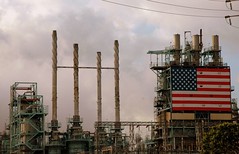Project Energy Independence
 Unfortunately I can't draw. If I could I would make a copy of this ad, but with a different image, "put a dead soldier in your tank."
Unfortunately I can't draw. If I could I would make a copy of this ad, but with a different image, "put a dead soldier in your tank."Obviously, energy usage is the #1 issue facing the nation. It is the primary factor that shapes U.S. foreign policy. See for example, this piece by Michael Klare, on Saudi Arabia and peak oil production.
But rather than talk about how cheap oil fuels sprawl, hurts the cities vis-a-vis the suburbs, kills Americans, leads citizens of other countries to hate the U.S. because of how the U.S. military-foreign policy often supports repression in oil supplying countries, I'd rather think about how again the center cities can reposition vis-a-vis the suburbs, around energy efficiency. There is a link in the "must read reports" section to the paper "Green Manhattan: Why New York is the greenest city in the U.S." from the New Yorker.
The article Tiny steps to save energy: Toronto's a North American leader in trying to curb power consumption, one apartment at a time is about energy initiatives in the City of Toronto that ought to be considered as part of an energy policy and strategy for the City of Washington.
Sweat glistens on Mympha Villorante's face, as she waits for the elevator in the busy, stifling lobby of her North York high-rise. The mother of two has just picked up a cotton shopping bag containing two energy-efficient light bulbs and several pamphlets from fellow tenants who've set up a table across from the mailboxes.
This is Tuesday, another hot, muggy afternoon in a month that has set Toronto records for heat and smog. The pamphlets, in the building's four major languages, explain six steps apartment dwellers can take to use less energy. The light bulbs are to make them familiar with a simple technology. Tenants are also asked to pledge they'll follow the conservation tips. After a brief, cheerful chat, Villorante, 37, jots her initials.
This modest event is part of an experiment aimed at cutting energy consumption in Villorante's building, and a sister high-rise across the street, by at least 20 per cent, and energy costs by more than $110,000. It's the first project of its kind in Canada, says Keith Stewart of the Toronto Environmental Alliance, who helped organize it. Most energy-efficiency programs are aimed at white, middle-class, university-educated people, who tend to be the "early adopters." This is the first to target people who make up the bulk of the city.
Six tenants hired as "animators" did much door knocking and talking to set the stage. In a couple of weeks, they'll hand out power bars that let people easily shut down computers, TVs and other equipment that draws electricity even after the "off" button is pressed. Later this summer, the landlord, the Toronto Community Housing Corp., will install energy-efficient stoves and refrigerators in the 343 subsidized units. It's cleaning and upgrading radiators.
All is not perfect in Toronto, as the Star reports the pluses and minuses in this sidebar, "Good and bad on T.O.'s energy record." But it's a start--and it engages citizens.
Also see these entries in the April archive of the blog, "Renewable Energy Trust Program in Massachusetts" and "Bush energy policy: the domestic angle."




0 Comments:
Post a Comment
<< Home